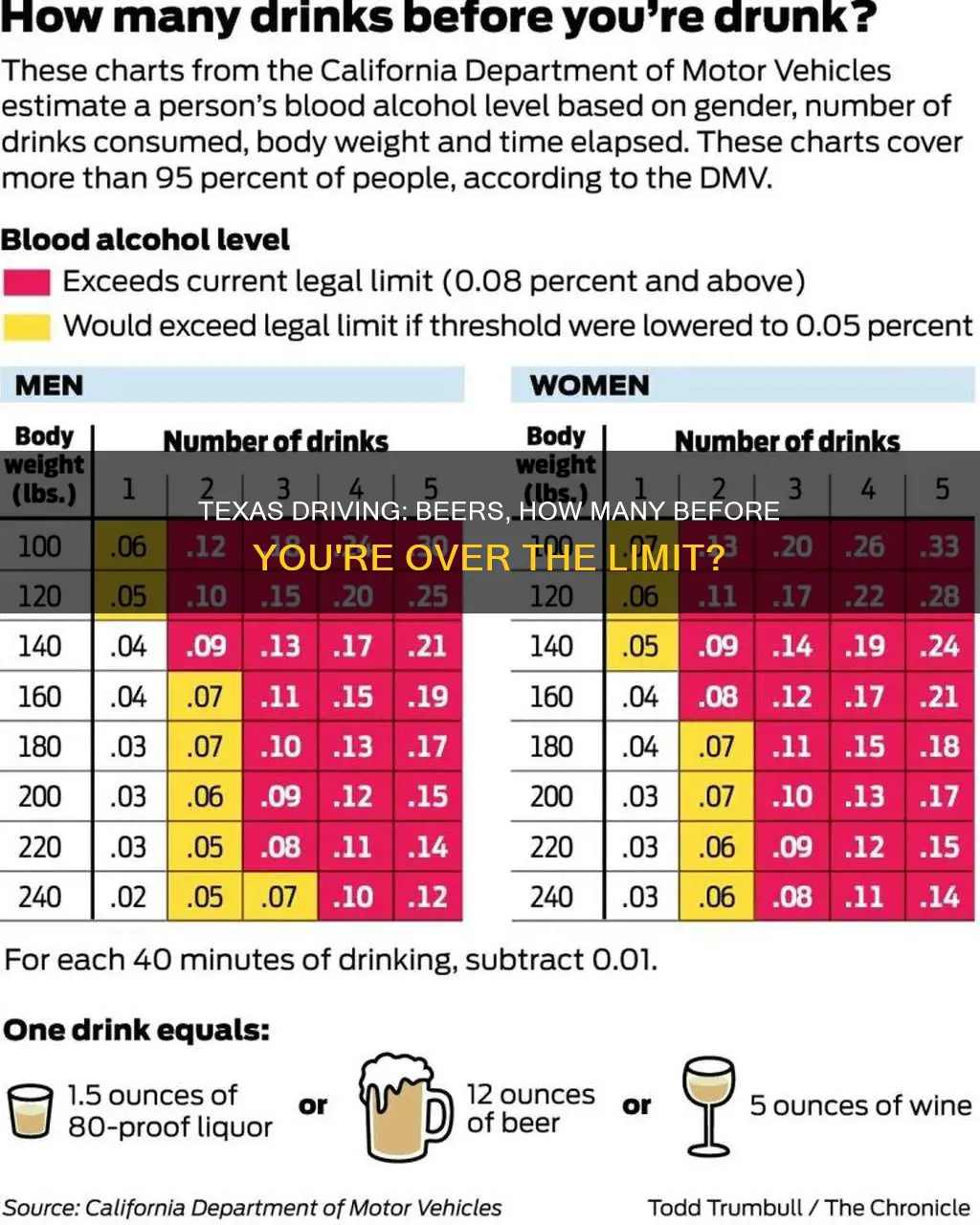
In Texas, a blood alcohol content (BAC) level of 0.08% or higher is considered legally intoxicated. While there is no formula to calculate how many drinks equate to this limit, several factors can affect an individual's BAC, including weight, alcohol tolerance, and food intake. For example, a 180-lb man may be able to drink 3.5 regular 12-ounce beers in an hour and maintain a BAC under the legal limit, while a 140-lb woman may only be able to consume 2.5 beers within the same timeframe. It is important to note that even one alcoholic beverage can impair an individual enough to make their driving unsafe, and the safest option is always to find an alternative way to get home.
| Characteristics | Values |
|---|---|
| Legal Blood Alcohol Concentration (BAC) Limit for Driving in Texas | 0.08% |
| BAC Limit for Commercial Drivers in Texas | 0.04% |
| BAC Limit for Drivers Under the Legal Drinking Age | 0% |
| Definition of a Standard Drink | 12 ounces of beer, 5 ounces of wine, or 1.5 ounces of hard liquor |
What You'll Learn

Texas's legal blood alcohol limit
Texas has strict laws regarding drinking and driving, and it's important to understand the legal blood alcohol limit to avoid putting yourself and others at risk.
In Texas, the legal blood alcohol limit for drivers 21 years and older is a blood alcohol concentration (BAC) of 0.08%. This limit is lower for commercial drivers, who cannot operate vehicles with a BAC above 0.04%. For drivers under the age of 21, Texas has a zero-tolerance policy, meaning any detectable amount of alcohol in their system is illegal.
The number of beers a person can drink and still stay under the legal limit varies depending on several factors, including weight, alcohol tolerance, and food intake. As a general estimate, a 180-lb man may be able to consume 3.5 regular 12-ounce beers in an hour and maintain a BAC under the legal limit. Meanwhile, a 140-lb woman may be able to consume 2.5 regular beers in an hour and stay under the 0.08% limit. However, it's important to note that these numbers are just estimates and can vary depending on the ABV of the beer and other individual factors.
Texas law enforcement officers use various methods to determine a person's BAC, including breathalyzer tests, blood tests, and field sobriety tests. If a person's BAC is above the legal limit, they can be arrested and charged with driving while intoxicated (DWI). The consequences of a DWI conviction in Texas can be severe, including fines, jail time, and suspension or revocation of the driver's license.
It's crucial to understand that drinking and driving is dangerous and can have devastating consequences. Even if you believe you are under the legal limit, your driving may still be impaired, and you could be charged with a DUI if an officer deems you too impaired to drive. The safest option is always to avoid drinking and driving altogether and to arrange alternative transportation if you plan on consuming alcohol.
Drinking Beer While on Shrooms: Safe or Risky?
You may want to see also

Factors affecting blood alcohol concentration
In Texas, a Blood Alcohol Concentration (BAC) level of 0.08% or higher is considered legally intoxicated. While there is no formula to calculate how many drinks equate to this limit, several factors affect an individual's BAC. Here are some factors that influence blood alcohol concentration:
Weight and Body Composition
Weight plays a significant role in BAC levels. A person who weighs more will generally have a lower BAC than someone who weighs less, even if they consume the same amount of alcohol. This is because individuals with higher body weight tend to have more water in their bodies, and water dilutes alcohol. Additionally, men tend to have more muscle mass and less fat than women, and since muscle tissue contains more water than fat tissue, men can have up to 10% more water in their bodies, further diluting the alcohol.
Gender
Gender also influences BAC levels. Women tend to have higher BAC levels than men after consuming the same amount of alcohol. This is because men's bodies generally have more water and less fat than women's bodies, and alcohol travels easily into fat cells. Additionally, women's hormones can impact how alcohol is broken down in the body.
Rate of Consumption
The rate at which alcohol is consumed affects BAC levels. The faster an individual drinks, the quicker their BAC will rise and the more rapidly they will become intoxicated. The liver can metabolize alcohol at a rate of approximately one standard drink per hour. If more than one drink is consumed per hour, the liver may not be able to keep up, leading to a higher concentration of alcohol in the bloodstream.
Food Consumption
Consuming food before or during alcohol consumption can impact BAC levels. Food slows down the absorption of alcohol by preventing it from passing directly into the small intestine, where most of the alcohol enters the bloodstream. Fatty foods are particularly effective in slowing down alcohol absorption as they take longer to digest.
Alcohol Concentration of the Drink
The higher the alcohol concentration in a drink, the faster the alcohol will be absorbed into the bloodstream. Hard liquor, for example, often has a higher alcohol content than a regular beer, and its effects will be noticed more rapidly.
Carbonated Beverages
Carbonated drinks can speed up the absorption of alcohol. They accelerate the passage of alcohol through the stomach and intestine into the bloodstream, leading to a more rapid increase in BAC.
Medications
Certain medications can amplify the effects of alcohol on the body. Medications such as aspirin, tranquilizers, antidepressants, and cough medicines can have interactions with alcohol, affecting an individual's BAC level.
Individual Metabolic Rate
Each person's metabolic rate can vary, influencing how their body absorbs and metabolizes alcohol. Factors such as muscle mass, blood volume, genetics, and health conditions can also play a role in absorption and metabolism rates.
Age
Age also affects BAC levels. After consuming the same amount of alcohol, an older adult will generally have a higher BAC than a younger adult.
Fatigue, Stress, and Mood
Alcohol can have a more pronounced effect on individuals who are fatigued, under stress, or experiencing mood changes. As alcohol is a depressant, it can exacerbate feelings of depression or stress.
Old Beer: Is It Safe to Drink After Two Months?
You may want to see also

Texas's commercial driving limit
Texas has strict laws regarding drinking and driving, with a maximum blood alcohol concentration (BAC) level for drivers of 0.08%. The state's commercial driving limit is even lower, capped at 0.04% BAC. This limit applies to all commercial drivers holding a Commercial Driver's License (CDL) and is half the legal limit for non-commercial drivers.
The lower limit for commercial drivers reflects the increased responsibility and danger associated with operating large commercial vehicles. For context, a 180-lb man may be able to drink 3.5 regular 12-ounce beers in an hour and maintain a BAC under the legal limit of 0.08%. However, to stay under the commercial driving limit, a man of the same weight would likely be limited to two or fewer drinks per hour.
The 0.04% limit for commercial drivers in Texas is a serious matter, with significant penalties for violations. Commercial drivers are subject to \"random\" BAC tests, and driving with a BAC above the limit can result in a 24-hour out-of-service order (OSO). Subsequent violations within ten years carry harsher penalties, including license revocation and fines.
It's important to note that the number of drinks to reach the commercial driving limit can vary depending on individual factors such as weight, alcohol tolerance, and food intake. Additionally, different types of beer, with varying alcohol content, can affect BAC levels. Therefore, commercial drivers should exercise caution and avoid drinking and driving whenever possible.
The Beer Hall Putsch: What If It Succeeded?
You may want to see also

Texas's zero-tolerance rule for underage drivers
Texas has a zero-tolerance rule for underage drinking and driving. This means that anyone under the legal drinking age of 21 cannot have any detectable blood alcohol content (BAC) when driving. Even a drop of alcohol found in their system can result in an arrest and charges for driving under the influence (DUI). The state has strict penalties for underage drinking and driving, reflecting its tough stance on this issue.
The first offence carries a 60-day driver's license suspension, 20 to 40 hours of mandatory community service, and participation in alcohol awareness classes. A second offence brings harsher consequences, including a 120-day license suspension, 40 to 60 hours of community service, and the requirement to attend alcohol awareness classes again. Additionally, the offender is not eligible for an occupational license in the first 90 days.
For a third or subsequent offence, the penalties become even more severe. The offender's driver's license will be suspended for 180 days, and they may face a fine ranging from $500 to $2,000 or jail time of up to 180 days. The penalties for underage drinking and driving in Texas are designed to deter minors from drinking and driving and to protect public safety.
It is important to note that the legal drinking limit in Texas is a BAC of 0.08% for most drivers. Commercial drivers have a lower limit of 0.04%. These limits are in place to ensure that individuals do not operate vehicles while impaired by alcohol, which can lead to dangerous situations and put themselves and others at risk.
Beer and Dieting: Can They Coexist?
You may want to see also

Texas's DUI charges
Texas has a maximum blood alcohol concentration (BAC) level of 0.08% for drivers. This is the same limit as in all other US states. Commercial drivers are subject to a lower limit of 0.04% BAC, and drivers under the legal drinking age of 21 cannot have any positive BAC reading.
There is no set formula to calculate how many drinks will put someone over the 0.08% limit, as this depends on a number of factors, including:
- Weight
- Gender
- Age
- Time of day
- Food consumption
- Alcohol tolerance
- Metabolic rate
As a general rule, men and women metabolise alcohol differently. Men's bodies tend to hold higher concentrations of the enzyme dehydrogenase, which processes alcohol. Men also tend to have a higher muscle mass, blood volume, and weight, all of which can affect absorption and metabolism rates.
For example, a 180-lb man may be able to drink 3.5 regular 12-ounce beers in an hour and keep his BAC under the legal limit. A 140-lb woman, on the other hand, may only be able to consume 2.5 regular beers in an hour while maintaining a BAC of less than 0.08%.
It is important to note that even one alcoholic beverage can be enough to impair a person's driving ability. The safest option is to always have a designated driver or to use a ride-sharing service such as Uber or Lyft if you plan on drinking.
In Texas, a police officer can ask a driver to submit to a BAC test or a field sobriety test if they have a reasonable suspicion of drunk driving. This includes observations such as swerving, open containers in the vehicle, or signs of impairment. Refusing to take a BAC test or failing a sobriety test gives an officer probable cause to make an arrest.
The penalties for driving under the influence (DUI) in Texas can include jail time, fines, and license suspension. For a first offense, drivers can face up to 180 days in jail, up to $2,000 in fines, and a license suspension of up to one year. The state of Texas may also require ignition interlock devices in some DWI sentences.
Digital Beer Rebates: How Do They Work?
You may want to see also
Frequently asked questions
In Texas, a blood alcohol content (BAC) level of 0.08% or higher is considered legally intoxicated. There is no set number of drinks a person can consume and still operate a motor vehicle safely. It depends on the individual's weight, alcohol tolerance, and food intake.
A 180-lb man may be able to drink 3.5 regular 12-ounce beers in one hour and keep his BAC under the legal limit of 0.08%.
A 140-lb woman may be able to consume 2.5 regular beers in an hour and maintain a BAC of less than 0.08%.







